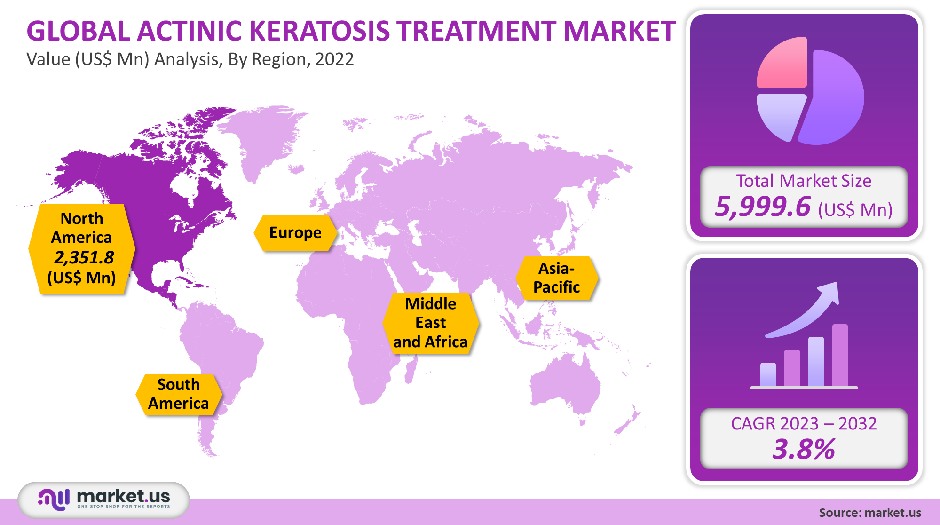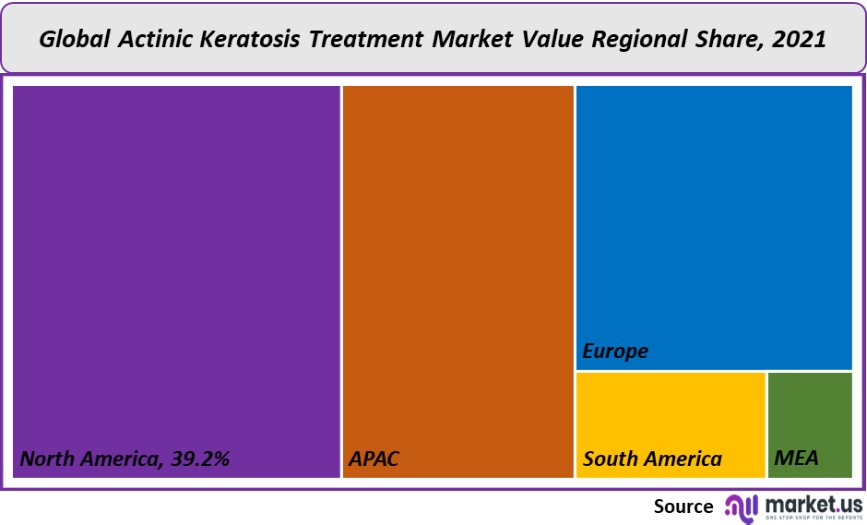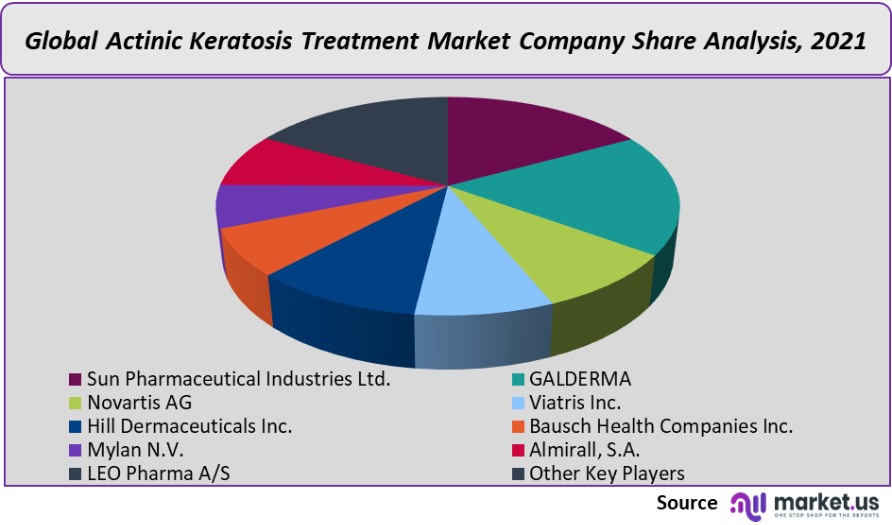Global Actinic Keratosis Treatment Market By Therapy (Surgery, Topical, and Photodynamic Therapy), By Drug Class (Nucleoside Metabolic Inhibitor, NSAIDs, and Others), By End-use, By Region and Companies - Industry Segment Outlook, Market Assessment, Competition Scenario, Trends and Forecast 2022-2032
- Published date: Aug 2022
- Report ID: 39701
- Number of Pages: 330
- Format:
- keyboard_arrow_up
Actinic Keratosis Treatment Market Overview
The Global Market for Actinic Keratosis Treatment was valued at USD 5.99 Billion in 2021. This market is expected to grow at a CAGR, of 3.8% between 2023-2032.
The growth of this market is expected to be driven primarily by an increase in the prevalence of the condition, an increasing number of geriatrics, and increasing awareness about it. In the U.S., for example, the prevalence ranges from 11 – 26%. It is the most frequently treated dermatologic disorder in outpatient settings in the U.S. The highest prevalence is found in Australia, where it is estimated to be 37-55% among adults 40 years old and older. The market has been negatively affected by COVID-19.
Global Actinic Keratosis Treatment Market Scope:
Therapy Analysis
With a greater than 64.6% share of the global market, surgical therapy dominated in 2021. This segment is expected to keep its dominant position over the forecast period. This will be due to the high adoption of cryotherapy in the treatment of AK. The fastest expected growth in the topical market is due to the growing acceptance of self-administered therapies and easy access to home-based treatment options.
This therapy, also known as field therapy, has a low rate of scarring. Photodynamic therapy is projected to grow at 6.9% annually over the forecast period. In the future, segment growth will be driven by increased adoption of non-invasive therapies and high-efficacy photodynamic therapy over cryotherapy. For patients with recurrent actinic keratosis, this therapy may be recommended.

Drug Class Analysis
Globally, the nucleoside metabolism inhibitors drug segment led with a share of more than 31.1% in 2021. Fluoroplex and Efudex were the key drivers of this growth. The widespread adoption and awareness of diagnostics and treatment strategies for this condition have led to the widespread adoption of field-directed treatments like 5-fluorouracil. The American Academy of Dermatology has issued new guidelines that strongly recommend 5-fluorouracil as a field treatment for AK. These will be the driving forces behind the segment’s growth. However, generics are likely to slow down segment growth in the future.
According to forecasts, the segment of photo-enhancers will experience the highest CAGR. Photodynamic therapy is on the rise and is expected to have a positive impact on the market growth of photo enhancers. It is expected that the segment will grow in the next few years due to the increased use of photo enhancers such as Ameluz, Photofrin, Levulan, and Metvix.
End Use Analysis
The global treatment market leader in 2021, with a 30.4% revenue share, was the hospital segment. This segment’s large share can be attributed in part to the availability of healthcare facilities, treatment rates, accessibility, healthcare spending, and many other factors. The penetration level of surgical therapies and the expanding usage of photodynamic therapy are driving the segment growth.
According to end-use, there are three segments in the market: hospitals, private clinics, and home care. Home care will grow at the fastest expected CAGR for the forecast period. The forecast period will see segment growth due to increased adoption of topical therapies, OTC drug availability, and patient convenience. Market leaders in topical drugs include Solaraze, Pennsaid, and Carac. Additionally, home-based treatment options have increased significantly due to the COVID-19 epidemic.
Key Market Segments
Therapy
- Surgery
- Topical
- Photodynamic Therapy
Drug Class
- Nucleoside Metabolic Inhibitor
- Immune Response Modifiers
- NSAIDs
- Photo Enhancers
- Others
End-use
- Hospitals
- Homecare
- Private Clinics
- Others
Market Dynamics
This is due to the increasing awareness of the disease worldwide. The Skin Cancer Foundation estimates that approximately 58 million people in the United States are affected by at least one form of actinic keratosis. The risk factors for developing the disease include severe baldness, sunburn, age, skin wrinkles, and a high likelihood of getting sunburned. Sun exposure can have a greater impact on patients living in Australia and New Zealand than it does in other regions. Globally, there is a growing number of people living with the disease.
The global market was adversely affected by COVID-19. The treatment and diagnosis rates for COVID-19 have decreased significantly in 2020 due to restrictions on visits from non-essential doctors and total lockdown across most countries. For example, the U.S. performed approximately 12.7 million treatments, including photodynamic therapy and topical drugs, for actinic keratosis in 2020. In 2019, however, it was around 15.1 million treatments. In addition, the American Academy of Dermatology kept in touch with dermatologists to limit visits for patients with non-urgent conditions such as actinic keratosis.
Expect to see an increase in drug approvals and the launch of novel treatments for the disease. Almirall S.A., for Klisyri (“tirbanibulin”), was approved by the U.S. FDA in December 2020. This drug is used to treat actinic keratosis on the scalp and face. Sun Pharmaceutical Industries Ltd. introduced Levulan Kerastick (a topical treatment for mild to moderate Actinic Keratosis of the scalp and face) in June 2020. One factor driving the market growth is the expected rise in adoption from the commercialization of novel drugs and the associated costs.
Over the forecast period, the number of new drugs to treat actinic keratosis will increase due to increased research and development activities. Market growth will be driven by pipeline candidates that are in the last phase of clinical trials. Actinic keratosis is a high-risk condition that can lead to skin cancer. This has led to a higher diagnosis and treatment rate. According to the Skin Cancer Foundation, squamous-cell carcinoma can be developed from untreated precancerous growths on the skin. About 10% of untreated, untreated actinic keratosis develops into cancerous. Most skin cancers are caused by actinic keratosis.
Regional Analysis
North America had a greater share than 39.2% of the global marketplace in 2021. It is expected that it will continue to be the dominant market over the forecast period. It is responsible for its dominance due to the high prevalence of diseases, growing consumer awareness, proactive government steps, technological advancements, and improvements in healthcare infrastructure.
Asia Pacific is expected to grow at the fastest CAGR in the forecast period. This growth can be attributed to an increase in the treatment rate for the disease, rising disposable income, and high disease prevalence in some countries such as Australia and New Zealand. In addition, pharmaceutical companies are expanding their market share with various strategies. Biofrontera, for instance, signed an exclusive agreement, in April 2020, with Maruho Co. Ltd. Japan, to commercialize Ameluz within the Asia Pacific region.

Key Regions and Countries covered іn thе rероrt:
- North America
- US
- Canada
- Mexico
- Europe
- Germany
- UK
- France
- Italy
- Russia
- Spain
- Rest of Europe
- APAC
- China
- Japan
- South Korea
- India
- Rest of Asia-Pacific
- South America
- Brazil
- Argentina
- Rest of South America
- MEA
- GCC
- South Africa
- Israel
- Rest of MEA
Market Share Analysis
Numerous generic pharmaceutical firms are engaged in the production and distribution of topical medications worldwide. Due to this, it is very competitive. In 2020, Almirall S.A. and Bausch Health Companies Inc. held a sizable market share.

Key Market Players
The market for actinic keratosis treatment is dominated by the following players:
- Sun Pharmaceutical Industries Ltd.
- GALDERMA
- Novartis AG
- Viatris Inc.
- Hill Dermaceuticals Inc.
- Bausch Health Companies Inc.
- Mylan N.V.
- Almirall, S.A.
- LEO Pharma A/S
- Other Key Players
For the Actinic Keratosis Treatment Market research study, the following years have been considered to estimate the market size:
Attribute Report Details Market Size in 2022
5.99 Billion
Growth Rate
3.8%
Forecast Value in 2032
9.03 Billion
Historical Years
2016-2020
Base Year
2021
Estimated Year
2022
Short Term Projection Year
2028
Projected Year
2023
Long Term Projection Year
2032
Report Coverage
Competitive Landscape, Revenue analysis, Company Share Analysis, Manufacturers Analysis, Volume by Manufacturers, Key Segments, Key company analysis, Market Trends, Distribution Channel, Market Dynamics, COVID-19 Impact Analysis, strategy for existing players to grab maximum market share, and more.
Regional Scope
North America, Europe, Asia-Pacific, South America, Middle East & Africa
Country Scope
United States, Canada and Mexico, Germany, France, UK, Russia and Italy, China, Japan, Korea, India and Southeast Asia, Brazil, Argentina, Colombia etc.Saudi Arabia, UAE, Egypt, Nigeria and South Africa
Frequently Asked Questions (FAQ)
What is the size of the Actinic Keratosis Treatment market in 2021?The Actinic Keratosis Treatment market size was US$ 5,999.6 million in 2021.
What is the projected CAGR at which the Actinic Keratosis Treatment market is expected to grow at?The Actinic Keratosis Treatment market is expected to grow at a CAGR of 3.8% (2023-2032).
List the segments encompassed in this report on the Actinic Keratosis Treatment market?Market.US has segmented the Actinic Keratosis Treatment market by geographic (North America, Europe, APAC, South America, and Middle East and Africa). By Therapy, market has been segmented into Surgery, Topical, and Photodynamic Therapy. By Drug Class, the market has been further divided into Nucleoside Metabolic Inhibitor, Immune Response Modifiers, NSAIDs, Photo enhancers, and Others. By End-use, market has been segmented into Hospitals, Homecare, Private Clinics, and Others.
List the key industry players of the Actinic Keratosis Treatment market?Sun Pharmaceutical Industries Ltd., GALDERMA, Novartis AG, Viatris Inc., Hill Dermaceuticals Inc., Bausch Health Companies Inc., Mylan N.V., Almirall, S.A., LEO Pharma A/S, and Other Key Players engaged in the Actinic Keratosis Treatment market.
Which region is more appealing for vendors employed in the Actinic Keratosis Treatment market?North America is accounted for the highest revenue share of 39.2%. Therefore, the Actinic Keratosis Treatment industry in North America is expected to garner significant business opportunities over the forecast period.
Name the key areas of business for Actinic Keratosis Treatment?The U.S., Canada, U.K., Germany, France, Italy, Spain, India, Etc., are key areas of operation for Actinic Keratosis Treatment Market.
Which segment accounts for the greatest market share in the Actinic Keratosis Treatment industry?With respect to the Actinic Keratosis Treatment industry, vendors can expect to leverage greater prospective business opportunities through the surgical therapy segment, as this area of interest accounts for the largest market share.
![Actinic Keratosis Treatment Market Actinic Keratosis Treatment Market]() Actinic Keratosis Treatment MarketPublished date: Aug 2022add_shopping_cartBuy Now get_appDownload Sample
Actinic Keratosis Treatment MarketPublished date: Aug 2022add_shopping_cartBuy Now get_appDownload Sample - Sun Pharmaceutical Industries Ltd.
- GALDERMA
- Novartis AG Company Profile
- Viatris Inc.
- Hill Dermaceuticals Inc.
- Bausch Health Companies Inc.
- Mylan N.V.
- Almirall, S.A.
- LEO Pharma A/S
- Other Key Players
- settingsSettings
Our Clients
|
Single User
$5,999
$2,999
USD / per unit
save 50% |
Multi User
$7,999
$3,499
USD / per unit
save 55% |
Corporate User
$12,999
$4,499
USD / per unit
save 65% | |
|---|---|---|---|
| e-Access | |||
| Data Set (Excel) | |||
| Company Profile Library Access | |||
| Interactive Dashboard | |||
| Free Custumization | No | up to 10 hrs work | up to 30 hrs work |
| Accessibility | 1 User | 2-5 User | Unlimited |
| Analyst Support | up to 20 hrs | up to 40 hrs | up to 50 hrs |
| Benefit | Up to 20% off on next purchase | Up to 25% off on next purchase | Up to 30% off on next purchase |
| Buy Now ($ 2,999) | Buy Now ($ 3,499) | Buy Now ($ 4,499) |









